|
|
|
Sort Order |
|
|
|
Items / Page
|
|
|
|
|
|
|
| Srl | Item |
| 1 |
ID:
189846
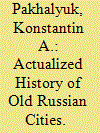

|
|
|
|
|
| Summary/Abstract |
In the regions of Central Russia, museum expositions actualize history
not only by putting it into the national context, but also by including
numerous references to the outside world. This is one of the mechanisms
by which representatives of local cultural elites, who are not directly related to the science and practice of international relations, provide guidelines
for the public understanding of world politics. Analysis based mainly on
field studies shows that the outside world simultaneously appears as both
something hostile and as a space of cooperation. “Russian antiquity” and
the Russian province are looking for conceptualization in international and
transnational perspectives, which are not always reduced to conflict.
|
|
|
|
|
|
|
|
|
|
|
|
|
|
|
|
| 2 |
ID:
088375
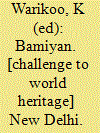

|
|
|
|
|
| Publication |
New Delhi, Third Eye, 2002.
|
| Description |
xx, 252p.
|
| Standard Number |
8186505660
|
|
|
|
|
|
|
|
|
|
|
|
Copies: C:1/I:0,R:0,Q:0
Circulation
| Accession# | Call# | Current Location | Status | Policy | Location |
| 054222 | 726.143/WAR 054222 | Main | On Shelf | General | |
|
|
|
|
| 3 |
ID:
027727
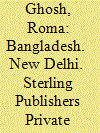

|
|
|
|
|
| Publication |
New Delhi, Sterling Publishers Private Limited, 1985.
|
| Description |
88p.hbk
|
| Series |
Lands and Peoples of the World
|
|
|
|
|
|
|
|
|
|
|
|
Copies: C:1/I:0,R:0,Q:0
Circulation
| Accession# | Call# | Current Location | Status | Policy | Location |
| 027555 | 952.92/GHO 027555 | Main | On Shelf | General | |
|
|
|
|
| 4 |
ID:
094082
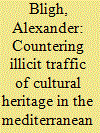

|
|
|
|
|
| Publication |
2010.
|
| Summary/Abstract |
Some of the most thrilling movies of all time depict imaginary or real thefts of artifacts from well-known museums. Topkapi (1964) is about the theft of the Ottoman Sultan's jewel-encrusted dagger from the Istanbul Museum; Entrapment (1999) is about the world's greatest art thief and his plans for the theft of a highly secured piece of artwork. More realistically, most people tend to turn to a news report on art stolen or recovered before they read their usual daily dose of hard news. Art and artifacts definitely capture the collective imagination. Art is usually viewed as the better dimension of human personality, while art thieves often enjoy a degree of infamy not usually associated with other kinds of felonies.
|
|
|
|
|
|
|
|
|
|
|
|
|
|
|
|
| 5 |
ID:
167574
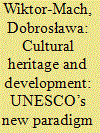

|
|
|
|
|
| Summary/Abstract |
In the 1980s, the process of convergence between culture and development began to emerge in the context of post-colonialism and changing geopolitical realities. Later on, along with increasing multilateralism, The United Nations Educational, Scientific and Cultural Organization (UNESCO) eventually became the main actor in promoting culture as a fourth pillar of sustainable development. The paradigm shift in the heritage-development agenda is examined in the context of growing aspirations of non-Western states to play an active role in the global heritage regime, and the interests and strategies of UNESCO’s secretariat and the member states. At first, heritage and development were perceived as separate or opposed fields. Recently, a sustainable development framework emerged as a new global development model. UNESCO has engaged in the shaping of the United Nations (UN) 2030 agenda, and advocated a pragmatic approach to heritage. This paper examines the evolution of ideas and concepts linking ‘development’ and ‘heritage’ forged at the forum of UNESCO as part of its Culture and Development framework. The role of the Global South in the paradigm change is highlighted.
|
|
|
|
|
|
|
|
|
|
|
|
|
|
|
|
| 6 |
ID:
114919
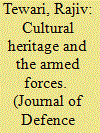

|
|
|
|
|
| Publication |
2012.
|
| Summary/Abstract |
Imagine if there is a war between India and Pakistan and the National Museum at New Delhi was vandalized and precious historical artifacts and other historical objects were stolen; or close your eyes and visualize India without the Taj Mahal which may be destroyed in an air attack. The standing bodhisattvas, dating back to seventh century AD, and the arms and armours of the Mughal era are some of the fabulous cultural wealth stored in the National Museum that is priceless for the nation and the loss of which can be the loss of the entire golden history of that era. That is literally what has happened to the Iraq National Museum in Baghadad (the Archaeological Institute of America has raised concern on the subject). Many artifacts contained in the museum were excavated from what has come to be known as the "Cradle of Civilisation" and artifacts-like a Sumerian marble head of a woman from Warka, dated 3000 BC and measuring 20 cm high-were found stolen from the National Museum in Baghdad. The fog of war and the instability that followed led to the looting and disappearance of thousands of such priceless artifacts from Baghdad National Museum and have sent alarm bells ringing regarding the preservation of cultural heritage in any armed conflict. The Chinese Cultural Revolution was another example of what harm can be done to the cultural heritage and how history can be obliterated and precious artifacts destroyed in the event of hostility breaking out.
|
|
|
|
|
|
|
|
|
|
|
|
|
|
|
|
| 7 |
ID:
181531
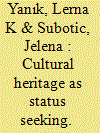

|
|
|
|
|
| Summary/Abstract |
This article explores the relationship between cultural heritage politics and international status-seeking. We advance a two-fold typology of status-seeking that explains why states engage in cultural heritage restoration practices at home and abroad. First, cultural heritage restoration can be an easy way to signal state respect of its multicultural past while providing cover for continuing anti-multicultural policies of the present. States with uncertain, challenged, or liminal international status use cultural heritage projects as a ‘standard of civilization’ of democracy, displaying themselves on the international stage as worthy of status and respect. Cultural heritage here is used as a strategy for international status affirmation. Second, states may engage in cultural heritage restoration beyond their borders, supporting or directly managing renovation of these sites in order to expand their imagined national cultural, political, and economic domain. Cultural heritage restoration projects here serve as a backdrop for powerful international economic alliances that can be used for status substitution—replacing one status-generating benchmark of ‘standard of civilization’ with another—economic prosperity. We illustrate these arguments with two recent cases of cultural heritage restoration that involve Turkey: the ‘Akdamar’ Church in Van, Turkey and the Tomb of Gül Baba in Budapest, Hungary.
|
|
|
|
|
|
|
|
|
|
|
|
|
|
|
|
| 8 |
ID:
170839
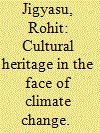

|
|
|
|
|
| Summary/Abstract |
Climate change is defined by the Intergovernmental Panel on Climate Change (IPCC) as "a change in the state of the climate that can be identified (e.g., using statistical tests) by changes in the mean and/or the variability of its properties, and that persists for an extended period, typically decades or longer"1. Climate change encompasses more than a worldwide trend of rising temperatures or 'global warming,' to include changes in regional climate characteristics such as humidity, rainfall and wind, and an observed increase in the frequency of extreme weather events, which will have biophysical, social, and economic impacts.2 However, climate change is not a figment of imagination of a distant future. Today, we are faced with rising sea levels, extreme temperatures, and more frequent and intense hydro-meteorological hazards that are already taking their toll on cultural heritage. Unfortunately, the scenarios presented by climate scientists are rather gloomy and the extent of impact on cultural heritage is likely to further accelerate exponentially. Using various case examples, this paper will explain how climate change is creating environmental conditions that are increasing the vulnerability of cultural heritage to various hazards, thereby exposing it to various risks. While there is a definite need to continue undertaking further research through a collection of highly calibrated data and sophisticated modelling for developing probable climate change induced scenarios for the future, it is equally important to invest in translating our progressively enhanced understanding of climate change risks into simple, achievable practices for day-to-day management of cultural heritage. These would include various preventive conservation techniques, enhanced monitoring systems, and adaptation strategies. Equally important is to rediscover and adapt traditional knowledge that has evolved over time in response to changing constraints and opportunities. This paper will showcase various practices from around the world to learn from their success and failure in dealing with the challenges posed by climate change.
|
|
|
|
|
|
|
|
|
|
|
|
|
|
|
|
| 9 |
ID:
076642
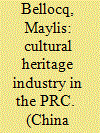

|
|
|
| 10 |
ID:
057320
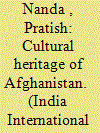

|
|
|
| 11 |
ID:
152438
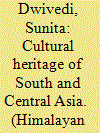

|
|
|
| 12 |
ID:
178897
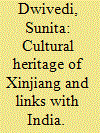

|
|
|
| 13 |
ID:
170294
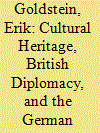

|
|
|
|
|
| Summary/Abstract |
Restitution of cultural objects was one of the topics covered in the Treaty of Versailles and the related peace treaties. Britain made specific claims in Article 246 relating to the Koran of Caliph Othman and the Skull of Sultan Mkwawa, whilst the Foreign Office considered other claims. Britain’s policy on cultural restitution influenced growing international norms, but it should also be seen in the context of Britain’s wider diplomatic concerns, stretching from the time of Castlereagh into the post-Second World War era.
|
|
|
|
|
|
|
|
|
|
|
|
|
|
|
|
| 14 |
ID:
127348
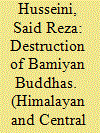

|
|
|
| 15 |
ID:
095460
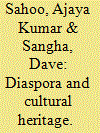

|
|
|
|
|
| Publication |
2010.
|
| Summary/Abstract |
The present paper examines the historical and contemporary context of Indian communities in Canada from a cultural heritage perspective and analyses the processes of migration, settlement and cultural identity. It also examines the challenges of developing museum exhibits which depict the Indian diaspora in Canada. Despite its colourful history and its growing size and prominence in Canadian society, the Indian diaspora has not been the subject of much interest by Canadian museums. While recognising the necessity of working with local communities and thereby reflecting local concerns, it is submitted that any museum exhibit attempting to portray the complex set of experiences of the Indian diaspora in Canada should include some portrayal of the highly marginalised position which the Indian community faced when it first established themselves in the early 1900s. In addition to this historical focus, any attempt to portray the contemporary Indian diaspora needs to portray its growing diversity and its efforts to maintain, and in many cases modify and 'hybridise', cultural practices. Such a display would also have to reflect the influence of transnational forces on the contemporary Indian diaspora. Ultimately, efforts by museums to develop exhibits reflecting the Indian presence in Canada will only further the aims of its widely praised state policy of multiculturalism.
|
|
|
|
|
|
|
|
|
|
|
|
|
|
|
|
| 16 |
ID:
139457
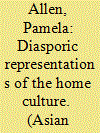

|
|
|
|
|
| Summary/Abstract |
The focus of this paper is the ways in which certain customs and traditions are actively selected and/or reinvigorated and subsequently authorised, by institutions or by individuals, as being key markers of the culture of the ‘homeland’. The cultural practices chosen for discussion are the kejawen mystical system as practised in Suriname and the acquisition of the Indonesian national language, bahasa Indonesia, in New Caledonia. The discussion is informed by two key ideas. The first is that immigrant communities designate certain cultural practices as being worthy of preservation as an ‘inheritance’ for the future. The second is the interplay between cultural practices and power or authority, which gels in scholarly discussions about ‘cultural heritage’. I argue that the continuation of a cultural practice or tradition lies as much with its authorisation by key individuals or institutions as it does with its purported authenticity.
|
|
|
|
|
|
|
|
|
|
|
|
|
|
|
|
| 17 |
ID:
132501
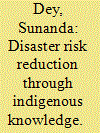

|
|
|
|
|
| Summary/Abstract |
Disasters occur at the interface of society, technology and environment and are fundamentally the outcomes' of the interaction. of these features. In very graphic ways, disasters signal the failure of a society to adapt successfully to certain features of its natural and socially constructed environment in a sustainable fashion (Smith and Hoffman, 2002).
|
|
|
|
|
|
|
|
|
|
|
|
|
|
|
|
| 18 |
ID:
132502
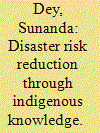

|
|
|
|
|
| Summary/Abstract |
Disasters occur at the interface of society, technology and environment and are fundamentally the outcomes' of the interaction. of these features. In very graphic ways, disasters signal the failure of a society to adapt successfully to certain features of its natural and socially constructed environment in a sustainable fashion (Smith and Hoffman, 2002).
|
|
|
|
|
|
|
|
|
|
|
|
|
|
|
|
| 19 |
ID:
132503
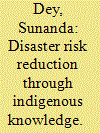

|
|
|
|
|
| Publication |
2014.
|
| Summary/Abstract |
Disasters occur at the interface of society, technology and environment and are fundamentally the outcomes' of the interaction. of these features. In very graphic ways, disasters signal the failure of a society to adapt successfully to certain features of its natural and socially constructed environment in a sustainable fashion (Smith and Hoffman, 2002).
|
|
|
|
|
|
|
|
|
|
|
|
|
|
|
|
| 20 |
ID:
147872
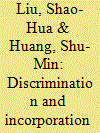

|
|
|
|
|
| Summary/Abstract |
This paper examines contemporary developments among Taiwan’s indigenous Austronesian peoples. We have reviewed major policy changes mainly since the 1980s and their impacts on later developments – both the positive improvements in general well-being and the persistence of ingrained problems among them. Major findings indicate two growing trends among Taiwanese Austronesians. One is the rise of interest in their cultures and efforts to preserve and restore selected indigenous customs and practices. The other trend is a continuous outflow of the indigenes from traditional tribal communities to urban centers for better employment, education, or health care. Their increasing urbanization also contributes to more inter-ethnic marriages and the loss of indigenous languages and practices. The case of Taiwanese Austronesians illustrates the impacts historical and politico-economic processes are having on indigenous peoples.
|
|
|
|
|
|
|
|
|
|
|
|
|
|
|
|
|
|
|
|
|